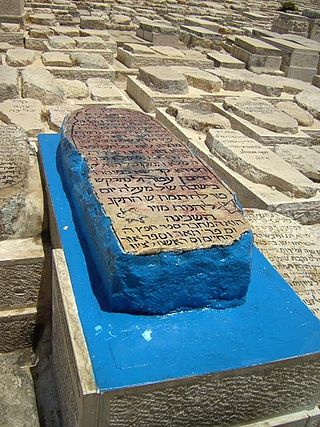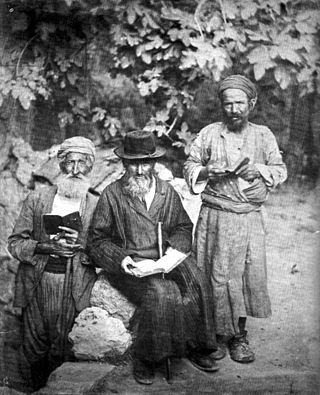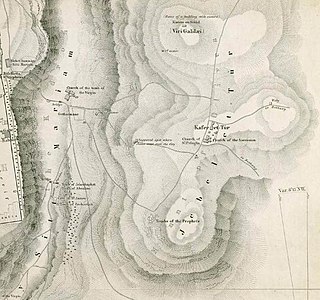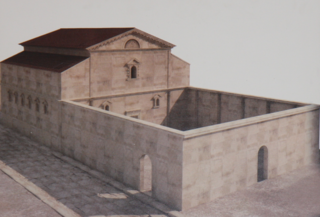
A synagogue, sometimes referred to by the Yiddish term shul and often used interchangeably with the word temple, is a Jewish house of worship. Synagogues have a place for prayer, where Jews attend religious services or special ceremonies, have rooms for study, social hall(s), administrative and charitable offices, classrooms for religious school and Hebrew school, sometimes Jewish preschools, and often have many places to sit and congregate; display commemorative, historic, or modern artwork throughout; and sometimes have items of some Jewish historical significance or history about the Synagogue itself on display.

Rabbinic literature, in its broadest sense, is the entire spectrum of rabbinic writings throughout Jewish history. However, the term often refers specifically to literature from the Talmudic era, as opposed to medieval and modern rabbinic writing, and thus corresponds with the Hebrew term Sifrut Chazal. This more specific sense of "Rabbinic literature"—referring to the Talmudim, Midrash, and related writings, but hardly ever to later texts—is how the term is generally intended when used in contemporary academic writing. The terms mefareshim and parshanim (commentaries/commentators) almost always refer to later, post-Talmudic writers of rabbinic glosses on Biblical and Talmudic texts.

Joseph ben Ephraim Karo, also spelled Yosef Caro, or Qaro, was the author of the last great codification of Jewish law, the Beit Yosef, and its popular analogue, the Shulchan Arukh. To this end he is often referred to as HaMechaber and as Maran.

Simchat Torah or Simhat Torah is a Jewish holiday that celebrates and marks the conclusion of the annual cycle of public Torah readings, and the beginning of a new cycle. Simchat Torah is a component of the Biblical Jewish holiday of Shemini Atzeret, which follows immediately after the festival of Sukkot in the month of Tishrei.

Chaim ibn Attar or Ḥayyim ben Moshe ibn Attar also known as the Or ha-Ḥayyim after his popular commentary on the Torah, was a Talmudist and Kabbalist. He is arguably considered to be one of the most prominent Rabbis of Morocco, and is highly regarded in Hassidic Judaism.
The baqashot are a collection of supplications, songs, and prayers that have been sung by the Sephardic Syrian, Moroccan, and Turkish Jewish communities for centuries each week on Shabbat mornings from the early hours of the morning until dawn. They are usually recited during the weeks of winter, from the Jewish festival of Sukkot through Purim, when the nights are much longer. The baqashot services can last for three to four hours. The Ades Synagogue in Jerusalem is the center of the Syrian practice today, and communities in Ashdod and Montreal are the center of the Moroccan practice.

Syrian Jews are Jews who lived in the region of the modern state of Syria, and their descendants born outside Syria. Syrian Jews derive their origin from two groups: from the Jews who inhabited the region of today's Syria from ancient times ; and from the Sephardi Jews who fled to Syria after the Alhambra Decree forced the expulsion of the Jews from Spain in 1492.

Syrian Jews had predominantly two origins: those who inhabited Syria from early times and the Sephardim who fled to Syria after the expulsion of the Jews from Spain in 1492 CE. There were large Jewish communities in Aleppo, Damascus, and Qamishli for centuries. In the early 20th century, a large percentage of Jews immigrated to Israel, the U.S., and Latin America. The largest Jewish community is now located in Israel and is estimated to number 80000.

Haim Palachi was a Jewish-Turkish chief rabbi of Smyrna (İzmir) and author in Ladino and Hebrew. His titles included Hakham Bashi and Gaon. He was the father of grand rabbis Abraham Palacci and Isaac Palacci and rabbi Joseph Palacci. He was a member of the Pallache family.
Abraham Hecht was a Chabad-affiliated American Orthodox rabbi, and president of the Rabbinical Alliance of America – Igud HaRabanim. Known as a "rabbi's rabbi" and a scholar of Torah, Hecht was regarded by some as one of America's most articulate Orthodox rabbinic leaders.

The Old Yishuv were the Jewish communities of the region of Palestine during the Ottoman period, up to the onset of Zionist aliyah and the consolidation of the New Yishuv by the end of World War I. In the late 19th century, the Old Yishuv comprised 0.3% of the world's Jews, representing 2–5% of the population of the Palestine region.

This article deals in more detail with some of the notable synagogues of Jerusalem that do not have their own page as yet.

Historic synagogues include synagogues that date back to ancient times and synagogues that represent the earliest Jewish presence in cities around the world. Some synagogues were destroyed and rebuilt several times on the same site. Others were converted into churches and mosques or used for other purposes.

The Jewish Cemetery on the Mount of Olives is the oldest and most important Jewish cemetery in Jerusalem. The Mount of Olives has been a traditional Hebrew/Jewish burial location since antiquity, and the main present-day cemetery portion is approximately five centuries old, having been first leased from the Jerusalem Islamic Waqf in the sixteenth century. The cemetery contains anywhere between 70,000 and 150,000 tombs, including the tombs of famous figures in early modern Jewish history. It is considered to be the largest and holiest historical Jewish cemetery on earth.
The Tunisian city of Kairouan, also known as Kirwan or al-Qayrawan was a world center of Talmudic and Halakhic scholarship for at least three generations.
Saul Adadi was a Sephardi Hakham, rosh yeshiva, and paytan in the 19th-century Jewish community of Tripoli, Libya. He was heavily involved in youth education, founding a yeshiva and co-founding and serving as principal of a Talmud Torah. He preserved the pinkasim of the Tripoli Jewish community, unpublished manuscripts of 18th-century Tripoli Jewish leader Rabbi Abraham Khalfon, and sefarim belonging to his father, Hakham Abraham Hayyim Adadi, a senior rabbi of the previous generation.
Sadqa Hussein February 3, 1876 – February 17, 1961) was a Sephardi dayan, mohel, and spiritual leader to the Iraqi Jewish community in Iraq and Israel. He taught thousands of students in Baghdad, and led the Iraqi expatriate community in Jerusalem. He was the founder and rosh mesivta of the Shemesh Sedaqah Synagogue in the Geula neighborhood of Jerusalem.

The Synagogue of Philippopolis is an ancient religious building built in ancient Philippopolis, now the city of Plovdiv, in the 3rd century AD. The synagogue is the only ancient Jewish temple found in Bulgaria. Today, only the foundation of the temple on part of the mosaic floor are preserved. The ruins of the ancient temple are located on Maria Luiza blvd.

Jews of Catalonia is the Jewish community that lived in the Iberian Peninsula, in the Lands of Catalonia, Valencia and Mallorca until the expulsion of 1492. Its splendor was between the 12th to 14th centuries, in which two important Torah centers flourished in Barcelona and Girona. The Catalan Jewish community developed unique characteristics, which included customs, a prayer rite, and a tradition of its own in issuing legal decisions (Halakhah). Although the Jews of Catalonia had a ritual of prayer and different traditions from those of Sepharad, today they are usually included in the Sephardic Jewish community.
































